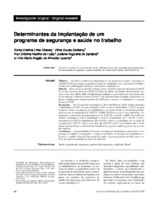Determinantes da implantação de um programa de segurança e saúde no trabalho
Date
2009Author
Metadata
Show full item recordAbstract
OBJETIVO: Identificar preditores da implantação de um programa de saúde e segurança no trabalho (PSST) que integra a vigilância à saúde do trabalhador com a segurança no trabalho, envolvendo a participação de técnicos, empresários e trabalhadores. MÉTODO: Neste estudo de desenho ecológico, foram estudadas empresas atendidas pelo PSST do Serviço Social da Indústria (SESI) no Estado da Bahia, selecionadas aleatoriamente, durante o ciclo entre 2005 e 2006. Os dados foram coletados em entrevistas com informantes chaves da empresa e relatórios técnicos do SESI. Com regressão linear múltipla, analisaram-se os fatores e subdimensões impulsionadores do PSST para a empresa, os trabalhadores e a equipe técnica do PSST. RESULTADOS: Das 78 empresas selecionadas (3 384 trabalhadores), 24,4 por cento haviam alcançado a implantação do PSST em grau avançado; 53,8 por cento em grau intermediário; e 19,3 por cento em grau incipiente. Fatores da empresa, dos trabalhadores e da equipe técnica se associaram positivamente ao grau de implantação do PSST (P 0,001). Destacou-se como o mais importante, isoladamente, a autonomia da gestão financeira do PSST (β = 4,40; P 0,001). Na análise bivariada, associaram-se com a implantação o nível de conhecimento (β = 1,58; P 0,05) e treinamento em SST dos trabalhadores (β = 0,40; P 0,001) e a articulação entre a equipe de segurança (β = 1,89; P 0,01) e a de saúde (β = 0,58; P 0,05). Esses achados não se modificaram após ajuste por escolaridade dos trabalhadores e gestores, salários, grau de risco e porte das empresas. CONCLUSÕES: A disponibilidade de recursos e de tempo dos trabalhadores para a saúde e a segurança no trabalho, a integração e o reforço de atividades de educação para trabalhadores e gestores e a melhor integração das equipes de saúde e segurança podem contribuir para o sucesso das ações de promoção da saúde nas empresas.(AU) OBJECTIVE: To identify predictors for the degree to which a program that integrates occupational health surveillance with labor safety, and involves occupational health/ safety specialists, company management, and employees, is implemented. METHOD: This ecological study evaluated companies implementing the occupational health and safety program (OHSP) proposed by the state of Bahia's regional department of Serviço Social da Indústria (Social Services for Industry, SESI) during the 2005-2006 cycle. The companies that participated were randomly selected. Data were collected through interviews with key contacts within the companies and from technical reports issued by SESI. Multiple linear regression was used to identify factors related to the company, employee, occupational/safety specialist, and any subdimensions that might promote OHSP implementation. RESULTS: Of the 78 companies selected (3 384 employees), the degree to which OHSP was implemented was " advanced" in 24.4 percent, " intermediate" in 53.8 percent, and " initial" in 19.3 percent. Company-related, employee-related and specialist-related factors were positively associated with OHSP implementation (P 0.001). The most important factor overall was the program's financial autonomy (β = 4.40; P 0.001). Bivariate analysis revealed that the degree of implementation was associated with the employees' level of health/safety knowledge (β = 1.58; P 0.05) and training (β = 0.40; P 0.001) and with communication between the occupational safety team (β = 1.89; P 0.01) and the health team (β = 0.58; P 0.05). These findings remained unchanged after adjustment for levels of education among managers and employees, salary/wages, company size, and risk. CONCLUSIONS: The time and resources available for employees to dedicate to occupational health and safety, the integration and reinforcement of employee and manager training programs, and improved relationship...(AU)
Translated title
Determinants in an occupational health and safety program implementation
Subject
URI
http://www.scielosp.org/scielo.php?script=sci_arttext&pid=S1020-49892009000300003https://iris.paho.org/handle/10665.2/9850
Citation
Chaves, Sonia Cristina Lima,Santana, Vilma Sousa,Leão, Inez Cristina Martins de,Santana, Jusiene Nogueira de,Lacerda, Lívia Maria Aragão de Almeida (2009) Determinantes da implantação de um programa de segurança e saúde no trabalho. Rev Panam Salud Publica;25(3) 204-212,mar. 2009. Retrieved from http://www.scielosp.org/scielo.php?script=sci_arttext&pid=S1020-49892009000300003
Collections
Related items
Showing items related by title, author, creator and subject.
-
Lou-Meda, Randall; Méndez, Sindy; Calgua, Erwin; Orozco, Mónica; Hall, Bria J.; Fahsen, Natalie; Taicher, Brad M.; Doty, Joseph P.; García Colindres, Julio; Soto Menegazzo, Carlos; Rice, Henry E. (2019)[ABSTRACT]. Objective. Patient safety is challenging for health systems around the world, particularly in low- and middleincome countries such as Guatemala. The goal of this report is to summarize a strategic planning ...
-
Ortega, Johis; Cometto, Maria Cristina; Zárate Grajales, Rosa A.; Malvárez, Silvina; Cassiani, Silvia; Falconi, Carmen; Friedeberg, Daniel; Peragallo-Montano, Nilda (2020)[ABSTRACT]. Patient safety is a critical topic in health care globally, with implications for nurses, physicians, administrators, and most importantly, patients and their well-being. Online distance learning (ODL) is widely ...
-
Organização Pan-Americana da Saúde; Communicable Diseases and Environmental Determinants of Health (CDE) (OPASUnited StatesWashington, D.C., 2023)Esta série de módulos de treinamento é destinada a distribuidores comunitários de medicamentos, agentes comunitários de saúde e todos os trabalhadores de saúde da linha de frente em programas de controle ou eliminação de ...




